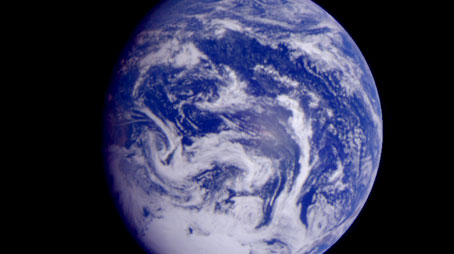

Feedbacks, links, thresholds and boundaries
The notion that a single stable equilibrium is the natural state of Earth’s environment is not supported by observations of past global changes.
The behaviour of the Earth system is typified not by stable equilibria, but by strong nonlinearities, where relatively small changes in a forcing function can push the system across a threshold and lead to abrupt changes in key aspects of system functioning.
Examples include the rapid end of ice ages, the exceptionally rapid warming and cooling events in the North Atlantic region, mega-droughts and other extreme events, and the ‘browning of the Sahara’.
More specifically, the past records show:
- Major switches in Earth system functioning occurred on much shorter timescales than the glacial/interglacial cycles;
- Changes were often rapid and large; in some cases temperature over large regions changed by up to 10 oC in a decade or less;
- Major abrupt transitions tend to strike during glacial periods (ice ages) But they are found in the last 12,000 years, especially in lower latitudes
- The changes demonstrate widespread spatial coherence, but are not always globally synchro¬nous
- Complex inter-hemispheric leads and lags occur that require feedback mechanisms for amplifying and propagating changes in both space and time.
The potential for abrupt change is extremely important for understanding the nature of the Earth system. The existence of such changes has been convincingly demonstrated by recently published palaeo evidence.
Unravelling the triggers of such changes and the internal dynamics of the Earth system that connect the trigger to the outcome is one of the most pressing challenges to improving understand¬ing of the planetary machinery.
Earth system thresholds
Dust in the Earth system
Terrestrial and marine biospheres are linked by dust: how it is generated, how it moves in the atmosphere, and where it is deposited.
A cooler and drier climate leads to less vegetation cover on land, which leads to an increase in bare soil and so dustiness.
The wind whips iron-containing dust from the land out over the oceans. When it falls on the ocean surface it acts as a fertiliser to phytoplankton (iron is a micro-nutrient). This causes a phytoplankton bloom, which increases the productivity of the ocean biota and consequently draws down carbon dioxide from the atmosphere.
Decreasing atmospheric carbon dioxide concentration leads to a cooler and drier climate, completing the positive feedback loop.
Dust in the ice
The record of dust deposition from the Vostok ice core hints at the importance of this feedback loop for the functioning of the Earth system in terms of the pattern of glacial-interglacial cycling.
Research has shown that a simulated dust field for the Last Glacial Maximum, consistent with the Vostok data, can provide enough iron to the Southern Ocean to stimulate a diatom bloom, drawing down carbon dioxide substantially.
The simulated carbon dioxide drawdown is also consistent with data from a range of marine sediment proxies. In the simulation several factors are found to contribute to higher atmospheric dust content in the Last Glacial Maximum - increased atmospheric transport as a result of stronger winds; a reduced hydrological cycle, especially lowered precipitation linked to cold ocean conditions; and reduced plant growth linked to both lower atmospheric carbon dioxide and drier climatic conditions.
Fuel for the pump
In this example, the synergy between the state of the terrestrial biosphere and changed atmospheric processes is crucial for generating greater dust entrainment, while the enhanced primary productivity of marine diatoms provides the fuel for the biological pump sequestering carbon in the deep ocean. Both terrestrial and marine life are vital components of the system of interactions that comprise this intriguing feedback loop in the Earth System.
Sahara: abrupt switch to desert
About 6000 years ago the climate in the Sahel-Sahara region was not as dry as today. Vegetation resembled modern-day African savanna. About 5500 years ago, an abrupt change in the regional climate occurred. This triggered a rapid conversion of the Sahara to desert.
The dramatic desertification of the Sahelian region in prehistoric times demonstrates several important features of Earth-system functioning.
The ultimate cause was a small, subtle change in Earth’s orbit, leading to a small change in the distribution of solar radiation on Earth’s surface.
Model simulations suggest that this small change nudged the Earth system across a threshold that triggered a series of biophysical feedbacks that led, in turn, to a drying climate.
Vegetation changed sharply in response to changing rainfall, and the region switched to desert and remains so. Model predictions of the resulting increase in wind erosion and deposition of sand off the West African coast agree remarkably well with observations.
The model simulations suggest that it was an interplay of atmosphere, ocean, vegetation and sea ice changes in widely separated parts of the planet that amplified the original orbital forcing.
The abrupt change from savanna to desert in North Africa demonstrates:
- abrupt changes can occur when thresholds are crossed,
- the biosphere plays a critical role in Earth system functioning,
- teleconnections are an essential feature of the planetary machinery.
For more information see the 2004 IGBP synthesis Global Change and the Earth System.